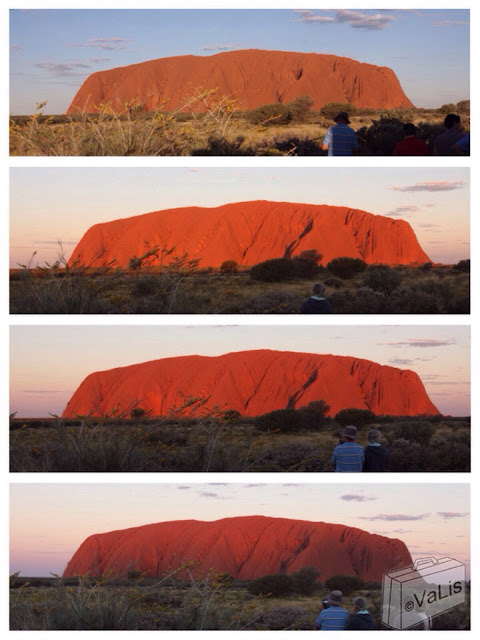When planning a trip to any destination, there are usually a few places on the 'must-do' list. Uluru, or Ayers Rock, is on most Australia lists. And it was on ours, even though it is quite remote. But hey... it's iconic!
 |
| Walking around Uluru |
We set out from Coober Pedy early morning, heading north. We had intended to drive to Erldunda (Some 400km). But Erldunda is not the most exiting place: it is a roadhouse at the Lasseter Highway turnoff, with a few emus in an enclosure. And since we there at noon, we decided to fill up and drive on.
That day we drove a distance of 750km, arriving at Yulara about half an hour before sunset. The only campsite in the vicinity of Uluru is at Yulara, and it's always busy. We were dishearted to hear they were fully booked that night....
Fortunately they do have an overflow field, where we could park for a night! A lot cheaper than the actual campground, but no electricity. Perfect!
 |
| Flowers at Uluru's base |
That first night we were too tired to get back in the car and actual go to Uluru, so we stayed at the village. Yulara is a village that is solely created to regulate tourism. It's just some hotels, a campsite, restaurants, shops and a petrol station in the middle of the desert, very artificial. But having said that, they have made a real effort to minimise scarring on its surroundings.
The efforts that stood out most for me: No building is higher than the surrounding sand dunes so they blend in from a distance (you don't actually see Yulara until you're there) and there is minimal lighting at night. In the middle of the village is the highest dune, planet with local species, from where you can stare at Uluru some 20km away. The lack of lighting can be annoying when you have to walk to an amenity block in the dark, but certainly ensures that you can enjoy some serious star gazing.
The efforts that stood out most for me: No building is higher than the surrounding sand dunes so they blend in from a distance (you don't actually see Yulara until you're there) and there is minimal lighting at night. In the middle of the village is the highest dune, planet with local species, from where you can stare at Uluru some 20km away. The lack of lighting can be annoying when you have to walk to an amenity block in the dark, but certainly ensures that you can enjoy some serious star gazing.
The next day we got up (too) late, and after breakfast, we drove to the National Park. We started at the visitor information centre, to learn a bit about the indigenous people's background, the Dreamtime and history of the area. A highly recommended visit.
By the time we were ready for a walk, it was almost eleven.... not a sensible time for a walk in the desert. But since it was winter, we decided to go ahead.
By the time we were ready for a walk, it was almost eleven.... not a sensible time for a walk in the desert. But since it was winter, we decided to go ahead.
 |
| Uluru's surface has many more holes than I expected |
You are still allowed to climb Uluru, but are requested not to, something I personally think you ought to respect. So we did the 10km base walk around it instead. An easy walk on level surface, with no shade. At all. I do not want to know what that's like in summer!
The base walk circles Uluru, so you see its different sides, and we were surprise how varied its surface is.
The base walk circles Uluru, so you see its different sides, and we were surprise how varied its surface is.
 |
| Grey-headed honeyeater at Mititjulu waterhole |
Uluru is seen as a visible reminder of Dreamtime tales, and as such, some parts are not to be photographed. Most of these areas have informative signs, telling you about the remnants of a particular tale visible on the surface.
One of my favourite areas was the Mutitjuli waterhole at the south side. We sat there for a good while, and watched the wildlife. Brightly coloured blue and red dragonflies, brown-red butterflies and the inquisitive grey-headed honeyeater.
One of my favourite areas was the Mutitjuli waterhole at the south side. We sat there for a good while, and watched the wildlife. Brightly coloured blue and red dragonflies, brown-red butterflies and the inquisitive grey-headed honeyeater.
It was a very tranquil place. We were amazed when we saw a video that was shot 6months later, that showed massive waterfalls at this exact spot!
 |
| Uluru Base walk |
That evening we returned to the park to watch the sun set over Uluru. This is what is features in all the brochures! It was very busy. Rows and rows of campervans. We had one of the last parking spots, and enjoyed nibbles and a drink while we waited comfortably, sat in the back of our van. It was a pretty sunset, though it didn't feel like all it's made up to be.
Until I saw my photos. They make it look amazing!
On our way back we drove under the light of the moon. It was full a moon that evening, and it must've been close, because it looked very big.
Until I saw my photos. They make it look amazing!
On our way back we drove under the light of the moon. It was full a moon that evening, and it must've been close, because it looked very big.
 |
| Classic Uluru sunset |

No comments:
Post a Comment
Please enter your name before commenting
Comment are subject to moderation